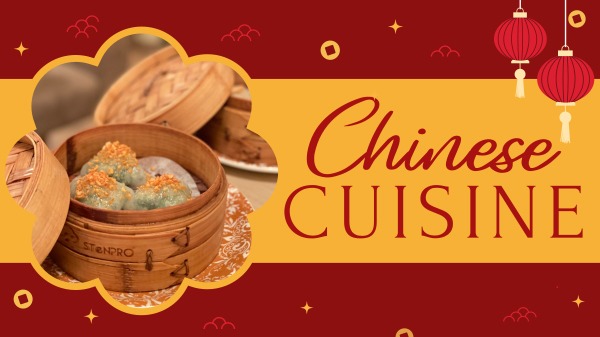Chinese cuisine is a diversified and rich comestible tradition that has evolved over thousands of years. It is known for its use of a wide variety of ingredients, complex savoury, and cooking techniques. The chronology of Chinese cuisine is closely tied to Chinese history itself, within different dynasties, through their sneak and seek talent developed by their own unique styles of cooking.
Chinese cuisine is one of the oldest and most diverse in the world. It is characterized by its use of a wide variety of ingredients, including meats, seafood, vegetables, and grains. Chinese cooks also use a wide range of approaches, such as stir-frying, steaming, and braising, to bring out the flavours of these ingredients.
Chinese cuisine has a long and rich historical background spanning thousands of years, and the earliest known Chinese cookbook dates to the Han Dynasty (206 BC-220 AD), and it is believed that Chinese cuisine began to take shape during the Shang Dynasty (16th-11th century BC). Chronologically, different dynasties and regions are famous for their own methodologies of cooking.
For example, the imperial court of the Ming Dynasty (1368-1644) was known for its luxurious and fascinating dishes; common people were simpler and more original pure.
China’s culinary expertise was elegated and varied as the nation, with a with a long and wide geographic variance. Chinese food offers an amazing variety of flavours, ingredients, and preparation methods. Every area has a distinct culinary character influenced by the local ingredients, environment, and culture. Chinese cuisine reflects the nation’s rich cultural diversity and legacy, from the fiery heat of Sichuan cuisine to the delicate nuances of Cantonese cooking.
The eight main regional traditions that make Chinese cuisine unique are the “Eight Great Cuisines, which are the cuisines of Cantonese, Jiangsu & Fujian, Hunan, Shandong & Anhui, Jiangsu & Zhejiang. Every Aerial cuisine varies by historical significance, the geography , where they are originally from, and ways of preparing the food and ingredients.
Cantonese cuisine of Guangdong Province is one of the most well-known Chinese traditions in the world. Its major focus is on using fresh ingredients and fascinated flavors. The most popular cooking techniques, which naturally maintain the ingredients’ flavours, are steaming and stir-frying. Cantonese cuisine is known for its dim sum, which consists of a range of tiny, tasty meals such as dumplings, buns, and rolls. Barbecued pork, or char siu, is another well-known meal. The pig is marinated in a savory, sweet marinade and then cooked to perfection.
Sichuan cuisine, or “Sichuan Province” food, is well-known for its robust, hot flavours derived from the generous use of chilli peppers and Sichuan peppercorns. One characteristic that differentiates this meal is the mala or characteristically numbing spiciness. Popular foods include kung pao chicken, cooked with diced chicken, peanuts, chilli peppers, and mapo tofu, soft tofu in a spicy, savory sauce. Another well-known dish is Sichuan hot pot, in which diners boil meats and veggies in a seething pot of hot broth.
Hunan cuisine, or “Hunan Province” Hunan cuisine is noted for its heat, much like Sichuan cuisine, but it tends to rely more on pickled vegetables and fresh chilies than on the numbing spice of Sichuan peppercorns. The flavours are strong, emphasizing savoury, sour, and spicy notes. A classic meal highlighting the audacious use of chiles is steamed fish heads with diced fiery red peppers.
Shandong Cuisine, or “Shandong Province” Because the province is situated along the northern coast, Shandong cuisine is renowned for its concentration on seafood. It is one of the oldest culinary traditions in China. With an emphasis on using fresh ingredients and basic cooking techniques like roasting and braising, the cuisine is frequently substantial and salty. This region’s flavours are reflected in dishes such as sweet and sour carp and braised sea cucumber.
Jiangsu Cuisine, or “Jiangsu Province” said by many as Su cuisine, Jiangsu food is characterized by harmony in seasoning and dish decoration. Prawns and other fish from lakes and rivers are some of the common ingredients in its cuisine. The overall cooking methods were centred around bringing out umami and sweetness for these dishes, and balance and harmony were prioritized. Lion’s head meatballs are large succulent pork meatballs stewed in a flavourful soupy broth and are among the signature dishes.
Zhejiang Province, also called the “Land of Fish and Rice,” specializes in delicious, light cuisine. Zhejiang, located on the east coastal plain, is rich in seafood, another staple used by the people of this province. Some of the most familiar foods are fish from West Lake covered in vinegar, as well as Dongpo pork, which goes through a slow cooking process. Even the dishes are elegant and, most of the time, sweet in some way.
Fujian Cuisine, or “Fujian Province,” a region close to the sea, influences the food type, emphasizing seafood and soups. ‘Clean’ tasting dishes are the general rule, rather delicate and slightly sweet, usually with only a subtle enhancement of the food’s natural flavours. Buddha Jumps Over the Wall is a well-known dish produced using a range of opulent ingredients, including chicken, abalone, shark fin, and sea cucumber. It is a rich and flavourful soup.
Anhui Cuisine “Anhui Province”, often referred to as Huizhou cuisine, Anhui cuisine is distinguished by its straightforward, rustic cooking methods that emphasize regional food and wild herbs. To bring out the inherent tastes of the ingredients, braising and stewing are traditional cooking techniques. A well-known Anhui delicacy is stinky tofu, a fermented tofu dish with a powerful smell and surprisingly mild taste.
China’s food and cuisine are dynamic and varied with nations. Chinese cuisine offers a gastronomic journey for those willing to explore, from the scorching spices of Sichuan to the delicate nuances of Cantonese cuisine. Every piece of food, whether you are dining at a posh restaurant or nosing about a busy night market, conveys a tale of custom, heritage, and culture. Although Chinese flavours impacted other cuisines worldwide, its roots are firmly established in the regional specialties and local ingredients that give it its distinct character.

Ms. Syeda Areej Fatima is PRCCSF Fellow and Participant of FJHS-PRCCSF Fellowship Program 2024.














